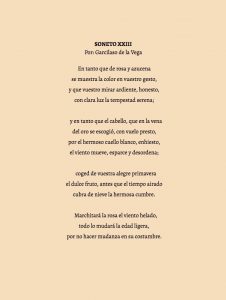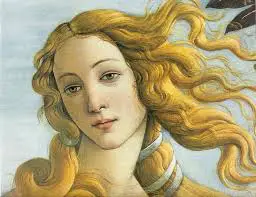 The period of European history referred to as the Renaissance was a time of great social and cultural change in Europe. It spanned from the sixteenth to the seventeenth century, and was regarded as the rebirth of antiquity. It was a time in which learning was transformed, and became an age of daring experimentation. Some of the most important literary figures in Spain’s history came from this golden period, one of them being the famous Garcilaso de la Vega. Garcilaso de la Vega’s Sonnet XXIII, perhaps one of the most significant sonnets of this epoch, focuses on the relationship of beauty and time.
The period of European history referred to as the Renaissance was a time of great social and cultural change in Europe. It spanned from the sixteenth to the seventeenth century, and was regarded as the rebirth of antiquity. It was a time in which learning was transformed, and became an age of daring experimentation. Some of the most important literary figures in Spain’s history came from this golden period, one of them being the famous Garcilaso de la Vega. Garcilaso de la Vega’s Sonnet XXIII, perhaps one of the most significant sonnets of this epoch, focuses on the relationship of beauty and time.
Sonnet XXIII Summary
Sonnet XXIII is one of Garcilaso de la Vega’s most famous works. It tells the story of a young man who is madly in love with a woman who does not return his affections. The young man tries everything he can to win her over, but she remains indifferent. In the end, the young man realizes that he will never be able to win her heart and he resigns himself to his fate. Sonnet XXIII is a beautiful and tragic love story that has been enjoyed by readers for centuries.
The message is successfully conveyed through the careful use of structure and poetic devices. This particular poem is made up of two quatrains and two tercets, of which often provide the conclusion of the argument developed in the quatrain. Each line contains eleven syllables making this sonnet hendecasyllable which is Italian in origin and was widely used in the early modern period. Like most sonnets in the Romance language, Garcilaso’s sonnet is Petrarchan in form. In the first quatrain, the main focus is the look and expression of the lady.
Sonnet XXIII Analysis
 The flowers, “rosa y azucena” are metaphors that reflect her facial expression and appearance, for example, the pink colour from the rose reflects the sign of vivacity in the lady. It could also be interpreted that the rose is a sign of her hidden passion for him. The white lily is a reflection of her honesty, purity and innocence. Here, Garcilaso is comparing the lady to a flower, soft, gentle and delicate. The adjectives “ardiente, honesto” are used to describe her gaze which gives us a further insight as to what this woman is like.
The flowers, “rosa y azucena” are metaphors that reflect her facial expression and appearance, for example, the pink colour from the rose reflects the sign of vivacity in the lady. It could also be interpreted that the rose is a sign of her hidden passion for him. The white lily is a reflection of her honesty, purity and innocence. Here, Garcilaso is comparing the lady to a flower, soft, gentle and delicate. The adjectives “ardiente, honesto” are used to describe her gaze which gives us a further insight as to what this woman is like.
If she has a burning gaze, then it is without a doubt that she has passion, but she is also honest which is again, a depiction of her calmness is. Furthermore, the second quatrain concentrates on her beauty from another angle; her golden hair. Garcilaso uses the words “se escogio” to describe how her hair got that colour, which almost personifies the hair, as if it is taking the gold from the mine itself. This personification is also emphasised as he is describing the movement of her hair, flowing against her pale neck as if it is alive. The golden colour of her hair also relates to the time period in which this poem is set; the Golden Age.
There is also a sense that this lady is slowly unravelling by letting her hair down. Up until now, the language has been of a tranquil nature as the reader is slowing taking in the lady’s beauty; however there is a sudden change of scene in the first tercet as the language used demonstrates a panicked tone through the use of the imperative tense “coged”. It creates tension as it makes the reader believe that her beauty will soon become undone. The “dulce fruto” is a metaphor for her beauty, and in this context, it seems that the ‘fruit is given to man to enjoy at the right moment.
If it is left too late, the fruit will have perished and not be the best quality it could have been. Too early and it will not have matured long enough to be thoroughly enjoyed. In line 10, the use of caesura is after “el dulce fruto” is effective as it makes the reader pause for a moment to think and capture the importance of this fruit within the poem. The following half of the line focuses on the “tiempo airado” which again makes the reader think of the idea of the movement or a passage of time; the different stages of this woman’s beauty is now becoming more apparent.
Furthermore, “airado” could have a double meaning in a sense that it reflects a time which destroys things; beauty. In the final line of this tercet, we are presented with a change of season through the phrase “cubre de nieve la hermosa cumbre”. This metaphor of snow is perhaps making a reference to the lady’s changing hair colour, from the golden colour related to springtime, to the grey, white colours concerned with winter. It also presents a gentle imagery of ageing and a loss of beauty.
In the second and final tercet of he Sonnet XXIII, we are moved from the present to the future through the use of the verbs “marchitara” and “mudara”. The sense of inevitability of future time’s destruction of the present is intensified by the use of these tense changes in an otherwise anticlimactic final tercet. Withering, is a natural process in the life of this rose. As it begins to wrinkle and reach the end of its day, one cannot attempt to cease this process, just like we are unable to interfere with the natural ageing of man. Moreover, the adjective “helado” which is used to describe the wind, is perhaps a metaphor for the death of this rose.
Its undeniable beauty is now no more as it has withered and been covered with the icy snow. In the second line, it is suggested that time will change many things as “todo lo mudara la edad ligera”, and amongst these things lies natural beauty. If we start to focus our attention now on the overall message that Garcilaso wanted to convey through this Sonnet XXIII, we are able to see that the main subject is the passage of time. In the first two quatrains, Garcliaso uses many adjectives to describe the woman’s beauty, and this ‘over-use’ is effective in slowing down the passage of time.
The way in which Garcilaso describes her features from her face, her eyes, her hair and to her neck, all in that order, depicts an imagery which has an elegant and subtle movement. This emphasises the notion that as long as beauty is ripe, we are blind to the fact that time is passing by so quickly, and sometimes we forget to take full advantage of the benefits of our youth before it’s too late . This argument is similarly presented through the use of anaphora which is the repetition of a word or phrase.
In the Sonnet XXIII, the phrase “en tanto que” is repeated three times; in the first line, the third line in abbreviated form, and in the fifth line. This poetic device creates tension as the reader is curious to know where the references to her beauty are leading to. Similarly, the use of enjambment throughout the poem helps to emphasis the idea that time doesn’t stop, it is a constant passage. The opening lines of the Sonnet XXIII state the two principal themes of the poem. These two themes run throughout the poem and give it a backbone: the red rose of passion and youth, and the white lily of chastity and restraint.
It’s not until the first tercet that we are greeted with the main theme of the poem for the first time in the line “coged de vuestra alegre primavera”. The imperative tense is used here to emphasise the poets appeal to the young lady to enjoy the fruit of her youth before time wastes it away. The tone here changes from serene to desperate as Garcilaso is emphasising how important it is to make good use of her fruit while it is still ripe. The source of this theme is Carpe Diem which from Latin, translates to ‘seize the day’, in other words, live every day like it is your last and seek every opportunity that arises.
This was a very popular perception in the Renaissance period and was a very common theme of many literature pieces. Carpe Diem can also be referred to as a classical topos reframed as a male apostrophe to a female recipient. Generally, two main characteristics exist in a classical Carpe Diem poem, and these are both displayed in Garcilaso’s sonnet: the privileging of the addressee’s body as the locus of time, and the projection of the poets own fear of ageing onto the female addressee.